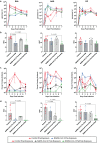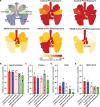Aerosol delivery of SARS-CoV-2 human monoclonal antibodies in macaques limits viral replication and lung pathology
- PMID: 37923717
- PMCID: PMC10624670
- DOI: 10.1038/s41467-023-42440-x
Aerosol delivery of SARS-CoV-2 human monoclonal antibodies in macaques limits viral replication and lung pathology
Abstract
Passively administered monoclonal antibodies (mAbs) given before or after viral infection can prevent or blunt disease. Here, we examine the efficacy of aerosol mAb delivery to prevent infection and disease in rhesus macaques inoculated with the severe acute respiratory syndrome coronavirus 2 (SARS-CoV-2) Delta variant via intranasal and intratracheal routes. SARS-CoV-2 human mAbs or a human mAb directed to respiratory syncytial virus (RSV) are nebulized and delivered using positive airflow via facemask to sedated macaques pre- and post-infection. Nebulized human mAbs are detectable in nasal, oropharyngeal, and bronchoalveolar lavage (BAL) samples. SARS-CoV-2 mAb treatment significantly reduces levels of SARS-CoV-2 viral RNA and infectious virus in the upper and lower respiratory tracts relative to controls. Reductions in lung and BAL virus levels correspond to reduced BAL inflammatory cytokines and lung pathology. Aerosolized antibody therapy for SARS-CoV-2 could be effective for reducing viral burden and limiting disease severity.
© 2023. The Author(s).
Conflict of interest statement
M.R.W., L.M.-S., and J.J.K. are co-inventors on patents that include claims related to the mAbs described. L.M.B. is Co-Founder and Managing Director of Zalgen Labs. He receives remuneration from the company. The remaining authors declare no competing interests.
Figures





Similar articles
-
SARS-CoV-2-neutralising monoclonal antibodies to prevent COVID-19.Cochrane Database Syst Rev. 2022 Jun 17;6(6):CD014945. doi: 10.1002/14651858.CD014945.pub2. Cochrane Database Syst Rev. 2022. PMID: 35713300 Free PMC article.
-
CCR2 Signaling Restricts SARS-CoV-2 Infection.mBio. 2021 Dec 21;12(6):e0274921. doi: 10.1128/mBio.02749-21. Epub 2021 Nov 9. mBio. 2021. PMID: 34749524 Free PMC article.
-
Antibody tests for identification of current and past infection with SARS-CoV-2.Cochrane Database Syst Rev. 2022 Nov 17;11(11):CD013652. doi: 10.1002/14651858.CD013652.pub2. Cochrane Database Syst Rev. 2022. PMID: 36394900 Free PMC article.
-
Type I and Type III Interferons Restrict SARS-CoV-2 Infection of Human Airway Epithelial Cultures.J Virol. 2020 Sep 15;94(19):e00985-20. doi: 10.1128/JVI.00985-20. Print 2020 Sep 15. J Virol. 2020. PMID: 32699094 Free PMC article.
-
The effect of sample site and collection procedure on identification of SARS-CoV-2 infection.Cochrane Database Syst Rev. 2024 Dec 16;12(12):CD014780. doi: 10.1002/14651858.CD014780. Cochrane Database Syst Rev. 2024. PMID: 39679851 Free PMC article.
Cited by
-
A Biparatopic Intrabody Renders Vero Cells Impervious to Ricin Intoxication.bioRxiv [Preprint]. 2024 Jul 3:2024.07.02.601761. doi: 10.1101/2024.07.02.601761. bioRxiv. 2024. Update in: Biochemistry. 2024 Oct 1;63(19):2391-2396. doi: 10.1021/acs.biochem.4c00385. PMID: 39005371 Free PMC article. Updated. Preprint.
-
Fc-binding nanodisc restores antiviral efficacy of antibodies with reduced neutralizing effects against evolving SARS-CoV-2 variants.J Nanobiotechnology. 2025 Jan 24;23(1):44. doi: 10.1186/s12951-025-03100-y. J Nanobiotechnology. 2025. PMID: 39856746 Free PMC article.
-
Trimeric Bet v 1-specific nanobodies cause strong suppression of IgE binding.Front Immunol. 2024 May 3;15:1343024. doi: 10.3389/fimmu.2024.1343024. eCollection 2024. Front Immunol. 2024. PMID: 38784378 Free PMC article.
-
Potent neutralization by a RBD antibody with broad specificity for SARS-CoV-2 JN.1 and other variants.Npj Viruses. 2024;2(1):55. doi: 10.1038/s44298-024-00063-z. Epub 2024 Nov 14. Npj Viruses. 2024. PMID: 39553825 Free PMC article.
-
Effect of obesity on the acute response to SARS-CoV-2 infection and development of post-acute sequelae of COVID-19 (PASC) in nonhuman primates.bioRxiv [Preprint]. 2025 Feb 22:2025.02.18.638792. doi: 10.1101/2025.02.18.638792. bioRxiv. 2025. Update in: PLoS Pathog. 2025 Jul 24;21(7):e1012988. doi: 10.1371/journal.ppat.1012988. PMID: 40027795 Free PMC article. Updated. Preprint.
References
Publication types
MeSH terms
Substances
Supplementary concepts
Grants and funding
LinkOut - more resources
Full Text Sources
Other Literature Sources
Medical
Miscellaneous

